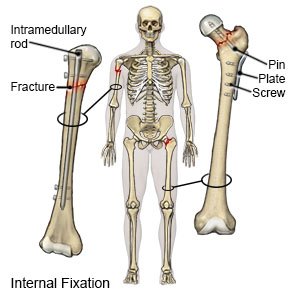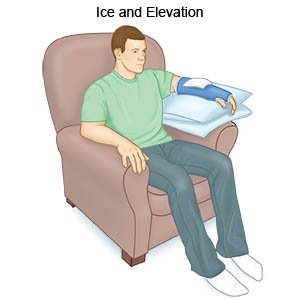ORIF of a Wrist Fracture in Children
Medically reviewed by Drugs.com. Last updated on Jun 5, 2024.
AMBULATORY CARE:
What you need to know about open reduction and internal fixation (ORIF) of a wrist fracture:
ORIF of a wrist fracture is surgery to fix a broken wrist. Open reduction means that the bone is moved back into the right place with surgery. Internal fixation means that hardware (such as screws, rods, or pins) is used to hold the broken bones together.
 |
How to prepare your child for ORIF:
- Your child's surgeon will tell you how to prepare him or her for surgery. He or she may tell you not to let your child eat or drink anything after midnight before surgery.
- Tell your child's surgeon about all medicines he or she currently takes. The surgeon will tell you if your child needs to stop any medicine for surgery, and when to stop. He or she will tell you which medicines your child should take or not take on the day of surgery.
- Tell your child's surgeon about all his or her allergies. Tell the surgeon if your child had an allergic reaction to anesthesia or antibiotics.
What will happen during ORIF:
- Your child may be given general anesthesia to keep him or her asleep and free from pain during surgery. He or she may instead be given local anesthesia to numb the area. Your child will be awake for surgery if he or she gets local anesthesia, but he or she should not feel pain. Your child's surgeon will make one or more incisions on your child's wrist. The broken bones will be put back into the correct position. Medical plates, screws, pins, or wires will be used to hold the broken bones together. A bone graft may be placed in or around the fracture to strengthen the wrist.
- X-rays may be taken during surgery to make sure the broken bone is set properly. X-rays also show if the pins, plates, and screws are placed correctly. Your child's surgeon will close the incision with stitches or staples. A splint will be placed over your child's wrist to prevent movement while it heals.
What your child should expect after ORIF:
Your child will be taken to a room to rest until he or she is fully awake. Healthcare providers will monitor your child closely for any problems. Do not let your child get out of bed until a healthcare provider says it is okay. When a healthcare provider sees that your child is okay, he or she may be able to go home. Medicine may be given to relieve or prevent pain or nausea.
Risks of ORIF for a wrist fracture:
Your child's tendons and nerves may get injured during or after surgery. The wrist may not heal properly. Your child may continue to have wrist pain. He or she may develop a life-threatening blood clot.
Call your local emergency number (911 in the US) for any of the following:
- Your child suddenly feels lightheaded and short of breath.
- Your child has chest pain when he or she takes a deep breath or coughs.
- Your child coughs up blood.
Seek care immediately if:
- Your child's arm or leg feels warm, tender, and painful. It may look swollen and red.
- Your child's incision wound is red, swollen, or draining pus.
- Your child's fingers look pale or blue, feel numb, or tingle.
- Blood soaks through your child's bandage.
Call your child's doctor or surgeon if:
- Your child's cast or splint breaks or gets damaged.
- Your child has severe pain, even after he or she takes pain medicine.
- Your child has a fever.
- You have questions or concerns about your child's condition or care.
Medicines:
- Prescription pain medicine may be given. Ask your child's healthcare provider how to give this medicine safely. Some prescription pain medicines contain acetaminophen. Do not give other medicines that contain acetaminophen without talking to a healthcare provider. Too much acetaminophen may cause liver damage. Prescription pain medicine may cause constipation. Ask your child's healthcare provider how to prevent or treat constipation.
- Do not give aspirin to children younger than 18 years. Your child could develop Reye syndrome if he or she has the flu or a fever and takes aspirin. Reye syndrome can cause life-threatening brain and liver damage. Check your child's medicine labels for aspirin or salicylates.
- Give your child's medicine as directed. Contact your child's healthcare provider if you think the medicine is not working as expected. Tell the provider if your child is allergic to any medicine. Keep a current list of the medicines, vitamins, and herbs your child takes. Include the amounts, and when, how, and why they are taken. Bring the list or the medicines in their containers to follow-up visits. Carry your child's medicine list with you in case of an emergency.
Care for your child:
- Apply ice as directed. Ice helps prevent tissue damage and decreases swelling and pain. Apply ice on your child's wrist for 15 to 20 minutes every hour or as directed. Use an ice pack, or put crushed ice in a plastic bag. Cover it with a towel before you apply it to your child's wrist.

- Elevate your child's wrist. Keep your child's wrist above the level of his or her heart as often as you can. This will help decrease swelling and pain. Prop your wrist on pillows or blankets to keep it elevated comfortably.

- Care for your child's splint or cast as directed. Ask when your child can bathe. Follow directions for bathing with a splint or cast. Wrap a plastic bag around your child's wrist. Tape the bag closed so water will not get in while your child bathes.
- Ask when your child can return to normal daily activities. Your child may need to avoid lifting objects that are heavier than 5 pounds. His or her healthcare provider may recommend that your child exercise his or her fingers and arm. The provider will give your child exercises to do.
Follow up with your child's doctor or surgeon as directed:
Your child will need to return to have his or her surgery wound checked and stitches or staples removed. Write down your questions so you remember to ask them during your visits.
© Copyright Merative 2024 Information is for End User's use only and may not be sold, redistributed or otherwise used for commercial purposes.
The above information is an educational aid only. It is not intended as medical advice for individual conditions or treatments. Talk to your doctor, nurse or pharmacist before following any medical regimen to see if it is safe and effective for you.
Further information
Always consult your healthcare provider to ensure the information displayed on this page applies to your personal circumstances.
